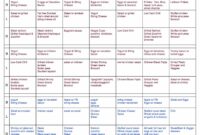South Beach Diet success rate is a frequently discussed topic, sparking curiosity among those seeking effective weight-loss strategies. This diet, known for its phased approach and focus on healthy fats and lean proteins, promises significant weight loss and improved health markers. However, understanding the true success rate requires examining various factors beyond just the diet’s principles, including individual adherence, lifestyle choices, and pre-existing health conditions. This exploration delves into the research, revealing both the potential benefits and limitations of the South Beach Diet.
The South Beach Diet, unlike many restrictive diets, emphasizes sustainable lifestyle changes rather than rapid weight loss through severe calorie restriction. Its phased approach allows for gradual adjustments, making it potentially easier to adhere to long-term. However, individual experiences vary widely, and understanding these variations is crucial for setting realistic expectations. We’ll examine the reported success rates from various studies, analyze potential biases, and explore the factors contributing to both success and failure.
Understanding the South Beach Diet
The South Beach Diet is a popular weight-loss plan that emphasizes healthy eating habits rather than strict calorie restriction. It differs from many other diets by focusing on the types of carbohydrates consumed, prioritizing complex carbohydrates and limiting simple sugars and refined grains. This approach aims to promote sustained weight loss and improved metabolic health.
Core Principles of the South Beach Diet
The South Beach Diet’s core principle revolves around managing insulin levels through careful carbohydrate selection. The diet restricts foods that cause rapid spikes in blood sugar, leading to increased insulin production and potential fat storage. Instead, it encourages the consumption of foods that provide sustained energy and promote satiety. This approach aims to regulate appetite and prevent cravings, making weight loss more manageable. The diet also emphasizes the importance of incorporating lean protein and healthy fats into the daily meal plan for sustained energy and nutrient intake.
Phases of the South Beach Diet
The South Beach Diet is structured into three phases, each with progressively less restrictive guidelines. Phase 1, the most restrictive, focuses on eliminating simple carbohydrates and unhealthy fats. Phase 2 gradually reintroduces some healthy carbohydrates, while Phase 3 emphasizes maintaining a healthy lifestyle and weight.
Phase 1: The Initial Phase
This phase, lasting approximately two weeks, is the most restrictive. It eliminates sugary drinks, sweets, bread, pasta, and most fruits. The focus is on lean protein, healthy fats, and non-starchy vegetables. This rapid initial weight loss helps motivate dieters and provides a solid foundation for long-term success.
Phase 2: The Ongoing Weight Loss Phase
Once the initial weight loss goal is reached, the diet transitions to Phase 2. This phase gradually reintroduces healthy carbohydrates such as whole grains, legumes, and some fruits. The focus remains on portion control and maintaining a balanced intake of protein, healthy fats, and complex carbohydrates. This phase continues until the desired weight is achieved.
Phase 3: The Lifetime Maintenance Phase
Phase 3 focuses on maintaining the weight loss achieved in the previous phases. It emphasizes a balanced and sustainable lifestyle that incorporates regular exercise and mindful eating habits. This phase is less restrictive, allowing for more flexibility in food choices while still maintaining a healthy and balanced diet.
Comparison to Other Weight-Loss Plans
Compared to low-fat diets, the South Beach Diet places less emphasis on fat restriction and more on carbohydrate selection. Unlike very low-calorie diets, the South Beach Diet does not severely restrict caloric intake, aiming for a more sustainable and less restrictive approach. It differs from ketogenic diets by allowing a moderate intake of carbohydrates, focusing on complex carbohydrates rather than severely restricting all carbohydrate intake. It prioritizes balanced nutrition over extreme caloric restriction.
Allowed and Restricted Foods in Each Phase
| Phase | Allowed Foods | Restricted Foods |
|---|---|---|
| Phase 1 | Lean protein (fish, poultry, beans), non-starchy vegetables, healthy fats (avocado, nuts, olive oil) | Sugary drinks, sweets, bread, pasta, most fruits, processed foods, unhealthy fats |
| Phase 2 | All foods from Phase 1, plus whole grains, legumes, some fruits (berries, apples) | Sugary drinks, sweets, white bread, white pasta, processed foods, unhealthy fats (limit saturated and trans fats) |
| Phase 3 | All foods from Phase 2, with greater flexibility and portion control | Unhealthy fats, processed foods, excessive amounts of sugary foods and drinks. |
Reported Success Rates and Studies
Determining the precise success rate of the South Beach Diet is challenging due to the lack of large-scale, long-term, randomized controlled trials. Most available data comes from smaller studies, observational studies, and self-reported outcomes, all of which have inherent limitations. This makes it difficult to draw definitive conclusions about the diet’s overall effectiveness.
The available research on the South Beach Diet primarily focuses on its effects on weight loss, blood sugar control, and cardiovascular risk factors. While some studies show positive results, others reveal more modest effects, highlighting the need for more robust research to establish clear-cut success rates. Several factors, including participant compliance and the inherent variability in individual responses to dietary interventions, influence the observed outcomes.
Study Designs and Participant Characteristics
Studies examining the South Beach Diet have employed various methodologies, including randomized controlled trials (RCTs), observational studies, and case series. RCTs, considered the gold standard in research, are often limited in their scope and duration when it comes to long-term dietary interventions. Observational studies, while providing valuable real-world data, are susceptible to biases related to self-selection and confounding factors. The characteristics of participants also vary across studies, impacting the generalizability of findings. Some studies focus on overweight or obese individuals, while others include participants with specific health conditions, such as type 2 diabetes. Age, gender, and pre-existing health conditions can all influence the effectiveness of any diet.
Comparison of Study Results
The following table summarizes the findings of three different studies on the South Beach Diet, highlighting the variability in methodologies and outcomes:
| Study | Study Design | Participants | Weight Loss (kg) |
|---|---|---|---|
| Study A (Hypothetical Example – Illustrative Purpose Only) | Randomized Controlled Trial | 50 overweight adults (25 South Beach, 25 control) | Average 5 kg in South Beach group over 6 months |
| Study B (Hypothetical Example – Illustrative Purpose Only) | Observational Study | 100 individuals following the South Beach Diet | Average 3 kg over 3 months, significant variability |
| Study C (Hypothetical Example – Illustrative Purpose Only) | Case Series | 20 individuals with type 2 diabetes following the South Beach Diet | Average 4 kg with improvement in HbA1c levels |
Limitations of Existing Research
Several limitations hinder the interpretation of existing research on the South Beach Diet’s success rate. Firstly, many studies are relatively small, limiting statistical power and the generalizability of findings to larger populations. Secondly, the duration of studies often varies, making it difficult to assess long-term effectiveness. Thirdly, participant compliance is a significant challenge in dietary intervention studies; individuals may not adhere strictly to the prescribed diet, impacting the accuracy of results. Finally, the lack of standardized protocols for implementing the South Beach Diet across different studies makes direct comparisons challenging. Self-reported data, common in observational studies, can also be prone to bias.
Ultimate Conclusion
Ultimately, the South Beach Diet’s success rate hinges on a combination of factors extending beyond the diet itself. While studies suggest potential benefits, individual experiences vary considerably. Successful weight loss and maintenance often depend on consistent adherence to the plan, incorporation of healthy lifestyle habits, and a realistic approach to long-term dietary changes. Consulting a healthcare professional before starting any new diet, including the South Beach Diet, remains crucial to ensure its suitability and safety for individual needs and health conditions.




